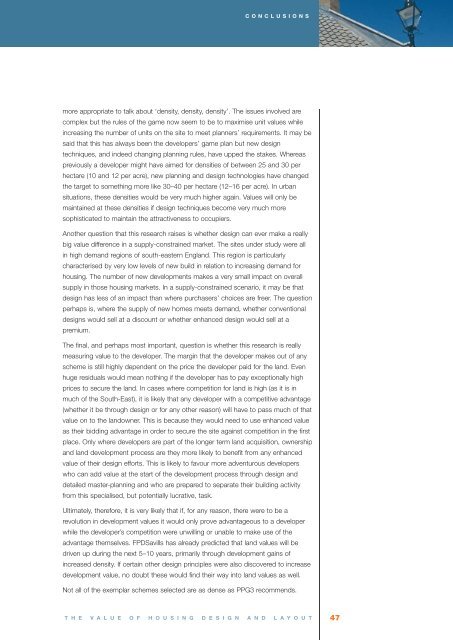The value of housing design and layout
The value of housing design and layout
The value of housing design and layout
Create successful ePaper yourself
Turn your PDF publications into a flip-book with our unique Google optimized e-Paper software.
CONCLUSIONS<br />
more appropriate to talk about ‘density, density, density’. <strong>The</strong> issues involved are<br />
complex but the rules <strong>of</strong> the game now seem to be to maximise unit <strong>value</strong>s while<br />
increasing the number <strong>of</strong> units on the site to meet planners’ requirements. It may be<br />
said that this has always been the developers’ game plan but new <strong>design</strong><br />
techniques, <strong>and</strong> indeed changing planning rules, have upped the stakes. Whereas<br />
previously a developer might have aimed for densities <strong>of</strong> between 25 <strong>and</strong> 30 per<br />
hectare (10 <strong>and</strong> 12 per acre), new planning <strong>and</strong> <strong>design</strong> technologies have changed<br />
the target to something more like 30–40 per hectare (12–16 per acre). In urban<br />
situations, these densities would be very much higher again. Values will only be<br />
maintained at these densities if <strong>design</strong> techniques become very much more<br />
sophisticated to maintain the attractiveness to occupiers.<br />
Another question that this research raises is whether <strong>design</strong> can ever make a really<br />
big <strong>value</strong> difference in a supply-constrained market. <strong>The</strong> sites under study were all<br />
in high dem<strong>and</strong> regions <strong>of</strong> south-eastern Engl<strong>and</strong>. This region is particularly<br />
characterised by very low levels <strong>of</strong> new build in relation to increasing dem<strong>and</strong> for<br />
<strong>housing</strong>. <strong>The</strong> number <strong>of</strong> new developments makes a very small impact on overall<br />
supply in those <strong>housing</strong> markets. In a supply-constrained scenario, it may be that<br />
<strong>design</strong> has less <strong>of</strong> an impact than where purchasers’ choices are freer. <strong>The</strong> question<br />
perhaps is, where the supply <strong>of</strong> new homes meets dem<strong>and</strong>, whether conventional<br />
<strong>design</strong>s would sell at a discount or whether enhanced <strong>design</strong> would sell at a<br />
premium.<br />
<strong>The</strong> final, <strong>and</strong> perhaps most important, question is whether this research is really<br />
measuring <strong>value</strong> to the developer. <strong>The</strong> margin that the developer makes out <strong>of</strong> any<br />
scheme is still highly dependent on the price the developer paid for the l<strong>and</strong>. Even<br />
huge residuals would mean nothing if the developer has to pay exceptionally high<br />
prices to secure the l<strong>and</strong>. In cases where competition for l<strong>and</strong> is high (as it is in<br />
much <strong>of</strong> the South-East), it is likely that any developer with a competitive advantage<br />
(whether it be through <strong>design</strong> or for any other reason) will have to pass much <strong>of</strong> that<br />
<strong>value</strong> on to the l<strong>and</strong>owner. This is because they would need to use enhanced <strong>value</strong><br />
as their bidding advantage in order to secure the site against competition in the first<br />
place. Only where developers are part <strong>of</strong> the longer term l<strong>and</strong> acquisition, ownership<br />
<strong>and</strong> l<strong>and</strong> development process are they more likely to benefit from any enhanced<br />
<strong>value</strong> <strong>of</strong> their <strong>design</strong> efforts. This is likely to favour more adventurous developers<br />
who can add <strong>value</strong> at the start <strong>of</strong> the development process through <strong>design</strong> <strong>and</strong><br />
detailed master-planning <strong>and</strong> who are prepared to separate their building activity<br />
from this specialised, but potentially lucrative, task.<br />
Ultimately, therefore, it is very likely that if, for any reason, there were to be a<br />
revolution in development <strong>value</strong>s it would only prove advantageous to a developer<br />
while the developer’s competition were unwilling or unable to make use <strong>of</strong> the<br />
advantage themselves. FPDSavills has already predicted that l<strong>and</strong> <strong>value</strong>s will be<br />
driven up during the next 5–10 years, primarily through development gains <strong>of</strong><br />
increased density. If certain other <strong>design</strong> principles were also discovered to increase<br />
development <strong>value</strong>, no doubt these would find their way into l<strong>and</strong> <strong>value</strong>s as well.<br />
Not all <strong>of</strong> the exemplar schemes selected are as dense as PPG3 recommends.<br />
T H E V A L U E O F H O U S I N G D E S I G N A N D L A Y O U T<br />
47

















